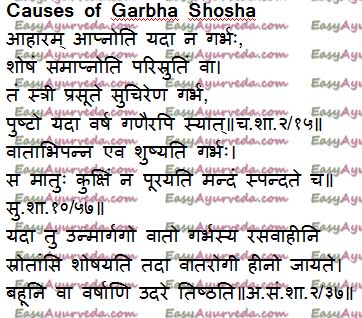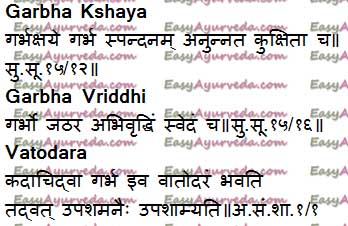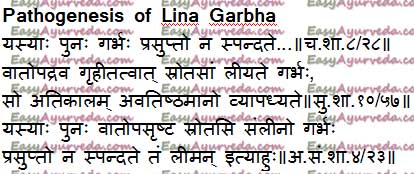Anomalies, Defects In Fetus, Ayurvedic Treatment
By Dr Raghuram Y.S. MD (Ay) & Dr Manasa, B.A.M.S
Growth of the fetus is influenced by many factors such as health, food habits of mother, lifestyle habits of mother, genetic composition of the fetus etc. Ayurveda explains in detail about anomalies of fetus and its management.
Garbha Kshaya, Garbha Vriddhi and Vatodara are three types of fetal disorders.
Table of Contents
Introduction
Garbha Shosha is a condition in which the fetus will undergo emaciation due to non-availability of proper nourishment. It is also called as Vatabhipanna Garbha. This means ‘fetus afflicted by Vata’. This points out to the fact that it is vata which has been aggravated due to deficit nutrition that will cause emaciation of the fetus.
Garbha = fetus
Shosha = dryness, emaciation
Read – Ayurvedic Home remedy for baby care – A traditional method
Causes
Causes of Garbha Shosha or Vatabhipanna Garbha
– Non-availability of proper nourishment to the fetus (Charaka)
– Vaginal discharge or bleeding after conception (Charaka)
– Affliction of fetus by vitiated vata (Sushruta) and subsequent deficit of ojas in fetus (Dalhana)
– Drying up of nutrition carrying channels by the upward movement of vayu leading to deficit nutrition to the fetus (Vagbhata)
– Slow supply or absence of flow of nutrition in the channels carrying rasa from mother to the fetus (Kashyapa)
– Conception taking place by union of vata vitiated sperms and healthy ovum in the uterus (Bhela)
Read – Diet And Lifestyle Advice For Vata Dosha Body Type
Sanskrit sloka

Due to above said causes, fetus suffers from shosha i.e. emaciation or dryness.
Emaciated fetus may attain proper growth after several weeks. The child birth may delay for many months. Vata is said to be the chief culprit in the causation of emaciation of fetus. Therefore garbha shosha is also called vatabhipanna garbha.
Due to affliction by vata, the fetus gets dried up. As a result it does not fill the mother’s belly. This means to tell that the belly of pregnancy is not evident as it needs to be. (Sushruta)
Read – Lifestyle Tips, Yoga And Home Remedies For Pedal Edema
Vata located in the yoni i.e. uterus gets mixed up with the semen (sperms) and the conception takes place by the union of vitiated semen and healthy artava (ovum). Then if bleeding occurs, the fetus gets destroyed and this condition is called as vatodara. (Bhela)
Read – Infant Care As Per Ayurveda: Initial 6 Months
Signs, Symptoms
Signs and Symptoms of Garbha Shosha or Vatabhipanna Garbha
– Dryness or emaciation of fetus
– Growth of fetus and child birth delayed for many months.
– Dried fetus doesn’t fill the abdomen of pregnant woman
– Deficit essence of tissues i.e. ojas in the fetus
– Development of vata disorders in fetus
Read – Vatala Yoni Vyapad – Causes, Symptoms, Treatment
Remedies
Ayurvedic remedies for Garbha Shosha or Vatabhipanna Garbha
– Avoidance of dry food substances
– Use of anabolic medicines, milk and meat soup regularly
– Recommendation for regular use of milk since milk provides nourishment and stability to the fetus
– Milk processed with licorice, fruits of kashmari (Gmelina arborea), with sariva (Hemidesmus indicus), and sweetened with sugar should be given for drinking
– Milk processed with sugar, kashmari and licorice should be administered
– Meat soup of carnivorous animals should be served by mixing it with anabolic herbs and fats
– Treatment prescribed for lina-garbha
Read – Your Child Does Not Eat Well? Causes, Ayurveda Solutions
Probable comparison of garbha shosha or vatabhipanna garbha Garbha Shosha or Vatabhipanna Garbha can be compared to a condition named ‘Intrauterine Growth Retardation of Fetus’ or ‘IUGR of fetus’ explained in the modern texts.
Garbha Kshaya
Garbha = fetus
Kshaya = decrease, depletion
Garbha Kshaya is a condition wherein there is decrease in height of uterus and absence of quickening.
This happens due to improper nutrition to fetus and is a condition which resembles Garbha Shosha. Since abdomen is not filled by growing fetus and height of uterus is not seen as it should be, it would be considered that the fetus has been depleted.
Read – Monthly Development Of Fetus – Ayurvedic perspective
Garbha kshaya sloka

Garbha Kshaya signs
Signs and Symptoms of Garbha Kshaya
- absence of quickening
- decrease in height of uterus
In this condition, the woman desires to eat well prepared meat of fetuses of deer, goat, sheep and hog along with fat and other roasted meat preparations. (Bhavamisra, Bhavaprakasha)
Read – Oil Massage To Baby: Precautions, Method, Ayurvedic Oil Combinations
Garbha Kshaya treatment
Treatment of Garbha Kshaya
Kshira Vasti –
Enema of medicated milk is given at 8th month of pregnancy.
Following this, unctuous cereals or fat rich food (medhya anna) should be served.
Medhya anda upayoga (eggs or testicles with fatty or unctuous foods) –
Cereals mixed with fat or testicles of goats and eggs of fish should be served. (Dalhana)
When there is decrease of any factor in body, there is always a desire for opposite substances i.e. substances likely to increase the decreased substance.
In garbha kshaya also there is decline of fetus. Therefore there will be affinity towards consuming those substances which may bring about nourishment and strength in the fetus.
Thus, the pregnant woman should be given the desired things since those are beneficial as they compensate the loss.
Read – Pregnancy Cravings – Reasons, Ayurvedic Explanation
Modern correlation
Probable Modern Comparison
Closely compared to under-weight fetus or intrauterine growth retardation.
Garbha Vriddhi
Garbha = fetus
Vriddhi = increase
Garbha vriddhi is a condition i.e. disorder of fetus in which there is increase in size of abdomen.
In this condition it is understood that, the fetus has overgrown than what it should be normally.
Signs and symptoms of Garbha Vriddhi
- Excessive increase in the size of abdomen (Sushruta)
- Perspiration (Sushruta)
- Difficult labor (Bhavamisra)
Treatment of Garbha Vriddhi
Dietetics and mode of life which are congenial, cleansing in nature and suppressive should be advised to be taken. These dietetics and modes of life should not cause loss of that dosha or dhatu but should be capable of decreasing the increased substances.
Read – Ayurvedic Care Of The Newborn Baby: Jatamatra Paricharya
Probable Modern Comparison
Macrosomia.
Vatodara
Vatodara = vata + udara ( abdomen)
Vatodara is a condition in which abdomen is increased even in the absence of pregnancy.
Vatodara Signs and Symptoms
Vatodara means the abdomen afflicted by vitiated vata. When the vitiated vata afflicts and fills the abdomen, there is increase in the size of abdomen.
Treatment of Vatodara
Vatodara subsides by treatments and formulations capable of subsiding the vata i.e. vata alleviating treatments.
Read – Senna Home Remedies: Flatulence, Constipation, Skin Diseases
Probable Modern Comparison
Flatulence.
Leena Garbha
Lina – adherent, latent
Garbha = fetus
Lina Garbha is a condition in which fetus becomes adherent due to affliction of vitiated vata and remains in the uterus for long duration causing various complications. Fetus becomes inactive and does not quiver. It gets delivered in time if it is properly developed and in other case ,delivered with great difficulty after many years. It may remain in the uterus throughout the life in some women.
Causes of Lina Garbha
- Abnormalities of channels caused by complications of vitiated vata (Sushruta)
- Constriction of channels or exit passages due to aggravated vata (Dalhana)
Pathogenesis of Lina Garbha
Due to above said causes, fetus gets adhered within the uterus. This fetus remains in the uterus for very long duration. As a result of its prolonged stay, the fetus produces many complications. (Sushruta)

The channels or exit passages of fetus (vaginal tract, cervical canal, and uterine cavity) are constricted due to aggravated vata. This results in prolong intrauterine stay of the fetus. In the later period the fetus may die. The dead fetus gets adhered to uterine cavity and hence called lina garbha. (Dalhana)
Though Charaka has not named this condition, due to similarity of clinical features and treatment, the condition explained by Charaka wherein the fetus doesn’t quiver being idle can be considered as explanation of Lina Garbha.
Signs and Symptoms of Lina Garbha
- Fetus doesn’t quiver (Charaka)
- Adherence of fetus in the uterine cavity, the fetus living in the uterus for prolonged period (Sushruta)
- Intrauterine death of fetus (Dalhana)
- Inactivity of fetus (Vagbhata)
Read – Bleeding During Pregnancy: Causes, Ayurvedic Treatment
Fate of Lina Garbha
- It can be delivered if the fetus developed properly during its prolonged stay in the uterus
- It may stay in the uterus for years and cause complications
- If not developed and matured properly, fetus can stay for long periods in uterus and come out with great difficulty through vaginal passage after years
- Adherent fetus may remain in uterus for entire lifespan of the woman
- Fetus may die following prolonged intrauterine stay
Ayurvedic remedies for Lina Garbh
- Mrudu sneha swedadi karma – Pregnant women should be treated with mild treatments including oleation, unctuous sudation, emesis and purgatives.
Strong forms of emetics etc should not be given because they may harm the fetus. - Achcha sneha i.e. use of only ghee for oral consumption as part of oleation should be avoided.
Instead, it should be given in the form of avacharana or vicharana sneha i.e. fats, mainly ghee mixed with some food items such as gruels etc should be preferred. - Properly processed and cooked, sweetened, cooled red shali rice should be served with meat soup of either hawk, fish, gavaya (species of ox), peacock, cock, partridge, sea-eagle, cow, iguana or any bird mixed with ghee.
- Red shali rice prepared in the above mentioned method with plenty of ghee
- Red shali rice prepared in the above mentioned method should be served with soup of black gram or soup of radish along with ghee
- Rice gruel prepared with meat soup of sea eagle or osprey mixed with fat in large proportions should be served
- Meat soup of hawk, cow, fish and peacock or soup of black gram or juice of radish mixed with large quantity of ghee.
- Meat soup of fatty animals, honey and wine made of raisins should be given
- Boiled gram should be cooked with black gram, sesame, and unripe fruit of and served. Following this, wine made from madhvika for seven days should be given to drink.
- Flour prepared from parched barley should be served mixed with sesame, black gram and unripe fruit of bilva along with milk.
- Woman should always be kept happy and pleasant
- Treatments mentioned for upavishtaka and upashuska fetal anomalies should be administered for treatment of lina garbha
Read – Vaginitis: Ayurvedic Treatment, Medicines, Home Remedies
Probable comparison of Leena Garbha
Lina Garbha can be compared to ‘absence of quickening of fetus’ of ‘death of mature or post-mature fetus’.
Click to Consult Dr Raghuram Y.S. MD (Ayu) – Email / Skype









